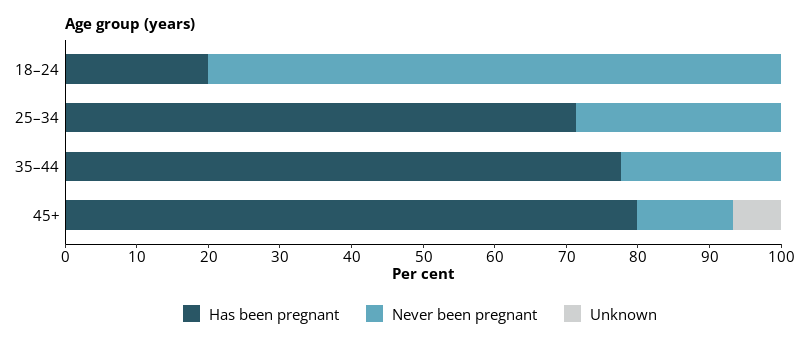Pregnancies
Most females in prison are mothers – and, on average, had their first pregnancy at a much younger age than females in the general community (AIHW 2019, 2023).
When compared with females who become pregnant after prison, females in Australia who are pregnant either before or during incarceration are more likely to have poorer birth outcomes, including babies of low birthweight, and to have children placed in out-of-home care by the age of 2 (Dowell et al. 2018).
Prison entrants who have been pregnant
Female prison entrants were asked whether they had been pregnant at some stage in their lives, and their age at their first pregnancy.
Over 7 in 10 (72%) female prison entrants reported they had been pregnant at some stage in their lives (Indicator 1.5.1).
Female entrants aged 18–24 were the least likely to report they had been pregnant at some stage in their lives (20%) (Figure 6.1). Female entrants aged 45 and over were the most likely to report being pregnant at some stage in their lives (80%).
Figure 6.1: Female prison entrants, history of pregnancy, by age, 2022

Notes
- Proportions are representative of this data collection only, and not the entire prison population.
- Excludes Victoria, which did not provide data for this item.
Source: Entrants form, 2022 NPHDC.
The average age at first pregnancy was 19.6 years (Indicator 1.5.2).
The average age at first pregnancy was 17.5 for Indigenous females, and 20.6 for non‑Indigenous females.
Females in custody who were pregnant
When compared with pregnant females in the community, pregnant females in prison are likely to have more mental health issues, and are more likely to smoke tobacco and to have used alcohol and other drugs while pregnant before incarceration (Dowell et al. 2018; Dowell et al. 2019; Knight and Plugge 2005; Mukherjee et al. 2014).
Imprisonment during pregnancy can provide females with better access to medical care. However, this may not be enough to mitigate the poorer health outcomes for mother and child, given the existing disadvantages. As well, with many females on remand and incarcerated for short periods – sometimes multiple times during the pregnancy – perinatal care might be interrupted, risking poorer outcomes for mother and child (Dowell et al. 2018; Dowell et al. 2019).
About 7.0 per 100 females received into custody in 2021 were pregnant (Indicator 1.5.3).
In 2021, 164 females in custody in participating prisons were pregnant. This represented about 7% of the 2,348 females received into participating prisons during that year. However, as females cycle through the criminal justice system, the same pregnant female might be received into custody several times throughout her pregnancy, and some females will not yet know they are pregnant.
AIHW (Australian Institute of Health and Welfare) (2019) The health of Australia’s prisoners 2018, AIHW website, accessed 17 April 2023.
—— (2023) Australia's mothers and babies, AIHW, Australian Government, accessed 03 October 2023.
Dowell CM, Mejia GC, Preen DB and Segal L (2018) ‘Maternal incarceration, child protection, and infant mortality: a descriptive study of infant children of women prisoners in Western Australia’, Health Justice 6(1):2, doi:10.1186/s40352–018–0060–y.
Dowell CM, Mejia GC, Preen DB and Segal L (2019) ‘Low birth weight and maternal incarceration in pregnancy: a longitudinal linked data study of Western Australian infants’, SSM – Population Health 7:100324.
Knight M and Plugge E (2005) ‘The outcomes of pregnancy among imprisoned women: a systematic review’, BJOG: An International Journal of Obstetrics and Gynaecology 112(11):1467–1474.
Mukherjee S, Pierre-Victor D, Bahelah R and Madhivanan P (2014) ‘Mental health issues among pregnant women in correctional facilities: a systematic review’, Women Health 54:816–842.


